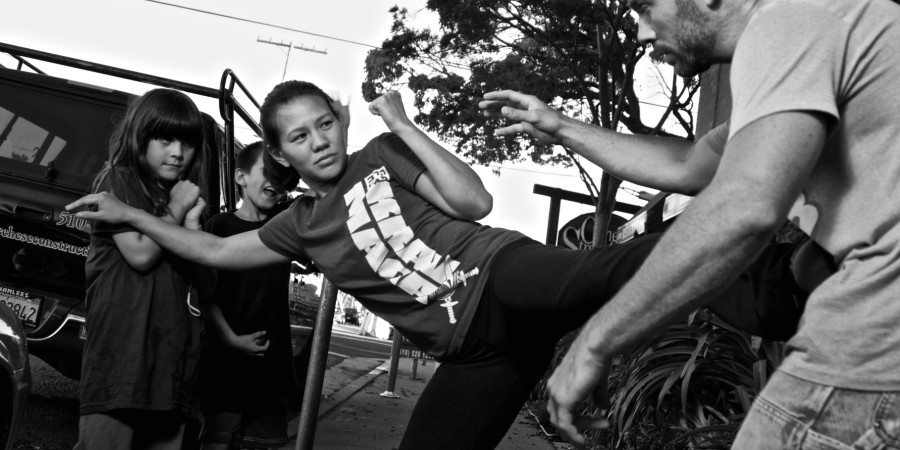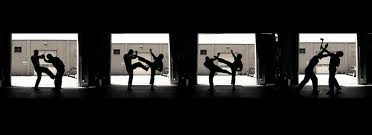No Katas. No Forms. No Nonsense.
Krav Maga is a truly comprehensive defensive tactics system that teaches all components and ranges of self defense, and develops real physical, mental, technical, and tactical skills that have been proven in combat in the most extreme situations on the planet. It is the ultimate combat and conditioning training system in the world.
Known for its intuitive and effective techniques, Krav Maga is easy to learn and retain, making you and your loved ones stronger and safer with every class you take.
Basic Premises of Krav Maga
- Don’t Get Hurt: The primary goal of Krav Maga is to provide you with the highest level of self-defense proficiency possible. However, if getting hurt is unavoidable, Krav Maga teaches you how to absorb the attack in the safest way possible, and to respond to the attack in the most effective way under the newly established conditions.
- Be Humble: Krav Maga teaches you not only how to survive an attack, but also how to avoid conflicts. Mental training is key to this premise. Avoid unnecessary conflicts by being willing to accept criticism and instruction from others, and by not boasting about your skills. Krav Maga training emphasizes mental control so that our egos or our mental states do not control us during a confrontation.
- Effective Action: Your mental and physical state is what will dictate your ability to handle a violent confrontation. Krav Maga training teaches you to make full use of your abilities and to take full advantage of your surroundings in order to effectively handle any situation.
- Become Proficient to Minimize Force: The goal of Krav Maga training is survival. Thus, a skilled Krav Maga practitioner does not need to inflict unnecessary harm upon his or her opponent. Rather, they are capable of ending the confrontation quickly and efficiently. In training Krav Maga, we emphasize consideration for our fellows even during a dangerous encounter, though we still honor the fact that no one has the right to do us harm.
Guiding Principles for Krav Maga Techniques
- Avoid Injury: Avoid danger whenever possible. The basic approach of all of your actions when using Krav Maga should be for defense. Always calculate the risks involved when deciding on a specific action.
- Follow the body’s natural reflexes: Krav Maga was developed to be an extension of these natural reflexes, which were then refined to meet the needs of any defender in any given situation.
- Counterattack in the most direct way possible: While considering the safety and correctness of tactics, Krav Maga encourages the defender to counterattack simultaneously with, or as quickly as possible after, the defense. As the common adage goes, the best defense is a good offense.
- Respond effectively: Always carefully check the nature of your response to ensure that the degree of force and the action itself is in accordance with, and required by the circumstances.
- Strike vulnerable points: Striking correctly at vulnerable points is the most efficient way to disable an attacker, allowing for escape and survival.
- Use any tool available: Your environment can provide many advantages to your survival. Look for any available items that can be used as a weapon for your own defense, and always be aware of any exits.
- There are no rules in Krav Maga: There are no technical limitations, no sportsmanship restrictions. No one is there to keep score. Survival is everything.
- Advance from closed skill to open skill: The underlying principle of Krav Maga training is to move from understanding a single, specifically-defined technique towards being able to improvise responses in accordance with each new situation that arises.
Foundations of Lions’ Self Defense Model
Lions Krav Maga operates out of an Empowerment Model. Empowerment-based self defense is the only form of self defense training with research evidence to support its effectiveness.
- Survivors of violence or abuse do not ask for, cause, invite, or deserve to be assaulted, violated, or otherwise maltreated. Regardless of the survivor’s behavior or judgment at the time of the abuse, it does not mean that they deserved it or are responsible for it.
- As an empowerment-based program, our classes aim to expand students’ freedom, empowering them to make their own decisions about where they go, what they do, and who they do it with.
- Whatever an individual’s decision is in a given self defense situation, their decision to survive the best way they can must be honored and respected.
- There is no single “right way” to survive. Empowerment-based self defense programs do not tell an individual what they “should” or “should not” do in any given self defense context. Instead, we provide a full range of tactical decision-making guidance, techniques that can scale up or down in level of force, and a way of analyzing risk & building safety strategies.
- As an empowerment-based program, we may point out what has worked effectively or ineffectively according to past experience or research, but we recognize that each situation is unique. The final decision rests with the individual to decide what’s best for them.
- The curriculum is evidence-based and trauma-informed. Different types of violence dynamics require different responses. As an empowerment-based program, we provide context to what we are teaching so that our students go into the world more empowered to recognize warning signs for different types of violence & take action early to protect themselves.
Evidence for Empowerment-Based Self Defense
Hollander, J. A. (2018). Empowerment self-defense. In L. M. Orchowski & C. A. Gidycz (Eds.), Sexual Assault Risk Reduction and Resistance: Theory, Research and Practice (pp. 221–244). Elsevier.
Hollander, J. A. (2018). Women’s self-defense and sexual assault resistance: The state of the field. Sociology Compass, 12(8), e12597.
National Women’s Martial Arts Federation. (n.d.). Empowerment model for teaching women’s self‐defense. Retrieved August 16, 2016, from http://www.nwmaf.wildapricot.org/empowerment‐model
Thompson, M. E. (2014). Empowering self-defense training. Violence Against Women 20(3), 351–359.Wanamaker, L. M. (2017).
Prevention, resistance, recovery, revolution: Feminist empowerment self-defence. In A. Taket & Crisp (Eds.), Eliminating Gender-Based Violence (pp. 98–110). Routledge.
Clay-Warner, J. (2002). Avoiding rape: The effects of protective actions and situational factors on rape outcome. Violence and Victims, 17(6), 691–705.
Fisher, B. S., Daigle, L. E., Cullen, F. T., & Santana, S. A. (2007). Assessing the efficacy of the protective action–completion nexus for sexual victimizations. Violence and Victims, 22(1), 18–42.
Guerette, R. T., & Santana, S. A. (2010). Explaining victim self-protective behavior effects on crime incident outcomes. Crime & Delinquency, 56(2), 198–226.
Tark, J., & Kleck, G. (2014). Resisting rape: The effects of victim self-protection on rape completion and injury. Violence Against Women, 20(3), 270–292.
Wong, J. S., & Balemba, S. (2018). The effect of victim resistance on rape completion. Trauma, Violence, & Abuse, 19(3), 352–65.


Comments are closed.